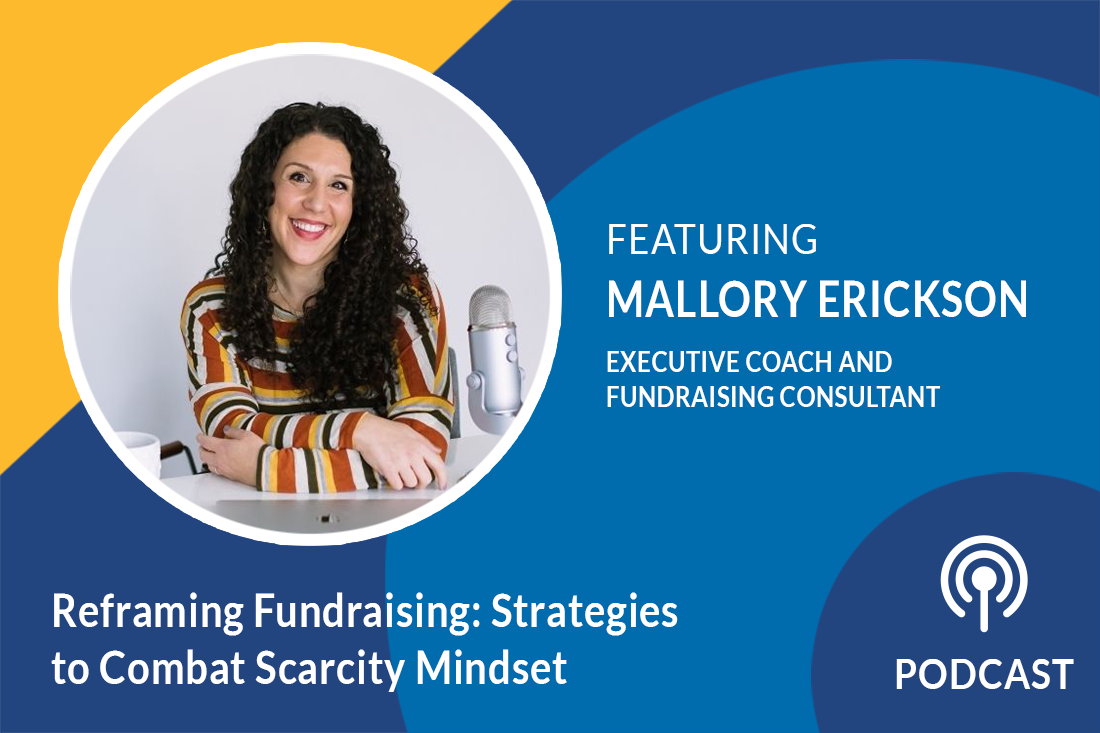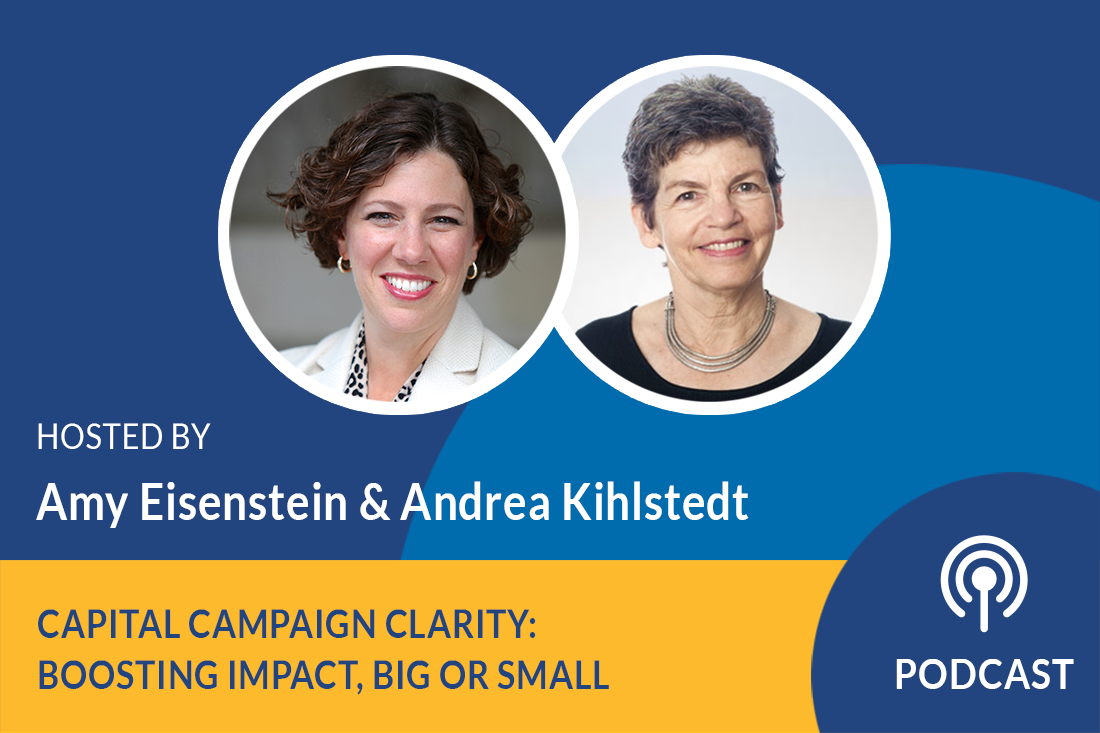Podcast: How a Big, Bold Vision Inspires and Guides Your Campaign

Season 2, Episode 59
What’s the one most important thing you can do at the beginning of your campaign to ensure your success? It’s all about having a big, bold vision.
In this episode, we’re going to share exactly how to think about your vision for your upcoming campaign.
Listen Now:
Amy Eisenstein:
What’s the one most important thing you can do at the beginning of your campaign to ensure success? I’m going to give you a hint. It’s all about having a big, bold vision. Stay tuned. We’re going to share exactly how to think about your vision for your upcoming campaign.
Hi, I’m Amy Eisenstein, and I am the CEO and co-founder of Capital Campaign Pro. I’m here with my colleague and co-founder, Andrea Kihlstedt. Andrea, why don’t you kick us off.
Andrea Kihlstedt:
Hi, there. I’m so happy to be here today. Vision, vision is so important. Sometimes people come to us and say:
Well, we want to raise money for a capital campaign. Why? Because we need money, because we need more money.
And that somehow isn’t very inspiring. But if someone comes and says to us:
We want to raise money because we’re going to invest in a new facility or a new van or new programs, and that’s really going to ramp up the amount of good we can do in our community, the number of people we can serve…
Well, then I find myself getting interested. And you know what? Donors find themselves getting interested too. So vision, particularly when it comes to capital campaigns, really does matter.
A Big, Bold Vision for your Capital Campaign Matters
Amy Eisenstein:
It really does. You’re asking donors to dig deep and make a special commitment, and a special gift, and an investment. They want to see something happen. They don’t want a little more of what you do. They want to see change in the world. And while you may not be able to cure homelessness or hunger, you can make progress towards it. And that’s what we’re talking about.
Andrea Kihlstedt:
Yes. Now, sometimes you’re fortunate and you have a leader in your organization that is a visionary that actually easily has big ideas and it has the courage to shoot for them. But sometimes you’re not so lucky.
Sometimes you have an executive director or a board that just watches the pennies, right? That while they understand the mission and they are behind the mission, they don’t talk about it in a compelling or exciting way. And when they think about a capital campaign, they’re really focusing on the dollars.
And if you’re a development director, that can sometimes put you in a challenging spot because it’s your job to inspire donors. And if you don’t have anything from the leadership of your organization to help with that, you’re in a bit of a pickle.
Amy Eisenstein:
Well, let’s say that it’s actually the executive director or the CEO’s job to inspire and vision for donors, but sometimes it does trickle down to the development director. If you’re not on the same page, it’s a problem. I think that, to me, we do want CEOs that are visionaries. It is problematic when the development director is thinking bigger than the executive director when we run into stumbling blocks.
Let Inspiration Guide Your Campaign
Andrea Kihlstedt:
But it is possible to inspire people. It’s even possible for a development director to inspire an executive director, for example, or to become a partner with the executive director, to say:
Listen, why don’t we together see if we can articulate a vision?
And one of the ways that we found is helpful to do that is to do some what we call blue-sky thinking. It’s when you get a team of people together, perhaps a team of staff members, perhaps staff members and some board members, and you say:
Let’s spend the next hour imagining that we have no financial constraints, that we could, over the next three to five years or 10 years, we could really make a difference in this organization because we really are going to be able to raise money to do that.
- Now, what would we do?
- What would we want to do?
- And what impact would we be after?
Now, I’ve found those conversations are really remarkable. They open people’s minds up. They get them out of this penny-pinching mentality that all of us in the nonprofit world tend to fall back to.
Have a Series of Visioning Sessions
Amy Eisenstein:
Yeah, I think that’s such a smart idea. I love the idea of having a blue-sky visioning session. And I think, in order for people to really break out of their shell and not hold back, I would have them for three minutes write down their ideas on some post-it notes, because they may not want to verbalize or articulate or say out loud some of the thoughts that they have. And we want all ideas on the table for this brainstorming.
So if you’re in the same room, have people put things down on a post-it note and put it up on the wall. It can be anonymous. And then read through some of the ideas because the more ideas you have at this brainstorming session, at this blue-sky, it’s going to spark things for others. We don’t want people to hold back.
Andrea Kihlstedt:
You could actually have a number of these meetings. You could have, for example, the program staff come together and say:
Gee, if the budget weren’t a constraint, what would you like that would make your work easier, better, and more effective?
That would be one kind of a blue-sky meeting. You could do the same thing with the board or executive staff. And then you could pull people together and say:
Let’s look at all the results here and see if we can make some sense of them. And is there a way in which we might want to move forward from this place of abundance rather than this place of scarcity?
Amy Eisenstein:
Yeah, that’s so interesting. I think so many nonprofits do operate with a sense of scarcity. Certainly people on your board do, maybe people on your senior leadership team do. So how do you break that cycle of thinking with the scarcity mindset and break into a mindset of abundance, or possibility, or inspiration to get those wheels turning, to generate those big ideas that will lead to a successful capital campaign?
Because if you are thinking small, your donors are going to think small. And this is the opportunity for you to think big, to be bold, and inspire your donors, to give bigger and consider bigger gifts than they’ve ever given before because the impact that you’re offering them is bigger than anything that you’ve offered them in the past.
Articulating Your Vision to Donors Will Help Inspire Gifts
Andrea Kihlstedt:
Yeah. Really, it’s only because of that that you can go to them at the same time they’re already giving annual fund gifts. If they’re giving you, let’s say, just for the sake of discussion, then you have a donor who’s giving you $5,000 a year regularly, and you go to that donor and you say, “Jane, I hope this year you would consider making a gift of $100,000.” Now, Jane’s going to look at you and say, “Well, why should I do that? What’s it for?” And you can’t just say, “Well, we just need more money.”
Amy Eisenstein:
We want to do a little more of the same. We want to do a little more of what we’re doing.
Andrea Kihlstedt:
We want more of the same. You have to have a better answer for that, which is to say, if we have done some planning and we realize that if we were to invest a million dollars in these aspects of our organization, we would greatly be able to increase the impact of what we do. Now we’re starting to talk.
So this is a super-important idea, I think, and I encourage you to try a little blue-sky planning meeting. See if you can light people up, see if you can give them permission to think about what the organization might do and might be if you weren’t always worried about whether you had the money to do something or not. You might find it quite transformational.
Amy Eisenstein:
And I will just add that once you’ve done some of this blue-sky thinking and you do have a big idea, and it seems to have traction on your board at your executive level, that’s the time to reach out to us, someone like Capital Campaign Pro, so that we can guide you on how to put together a campaign plan and how to move from your blue-sky thinking and your big vision towards actually making it a reality and raising the funds necessary to… How do you say it? Put the boots on the ground, the shovel in the ground,
Andrea Kihlstedt:
Shovel on the ground. Right.
Amy Eisenstein:
Whatever it is. Whatever it is.
Andrea Kihlstedt:
Get going.
Amy Eisenstein:
Yeah, get it going. Yeah.
Andrea Kihlstedt:
Get it going.
Transforming Your Organization Starts With a Vision
Amy Eisenstein:
But I think back to how we started this conversation, there are going to be people at your organization who don’t think big, who aren’t visionaries, who like the status quo. I mean, change is hard. Campaigns are daunting, and so, it’s much easier to put your head to the grindstone and keep doing what you’re doing.
But if you haven’t done a campaign in 10 years, your organization is stagnant, probably. And we encourage you to think about having this blue-sky visioning session as a first step to see what the possibilities are and what you could imagine for your organization, your community, your clients.
Andrea Kihlstedt:
Try one of these and let us know what happens.
Amy Eisenstein:
Yeah, we’re eager to hear. Let us know how it goes.
Alright, Andrea. I think that’s a good conversation. We’ve got people’s minds churning and turning hopefully on how to start this blue-sky thinking and really encourage you. If you are considering a campaign, you do need to have a big vision for donors to get on board and get excited.
It’s not about just growing your annual fund or having a rainy day fund. It’s about transforming your organization and what you can do for the community and your corner of the world.
Andrea Kihlstedt:
Thanks, Amy.
Amy Eisenstein:
Thanks for listening. We’ll see you next week.



Leave a Comment